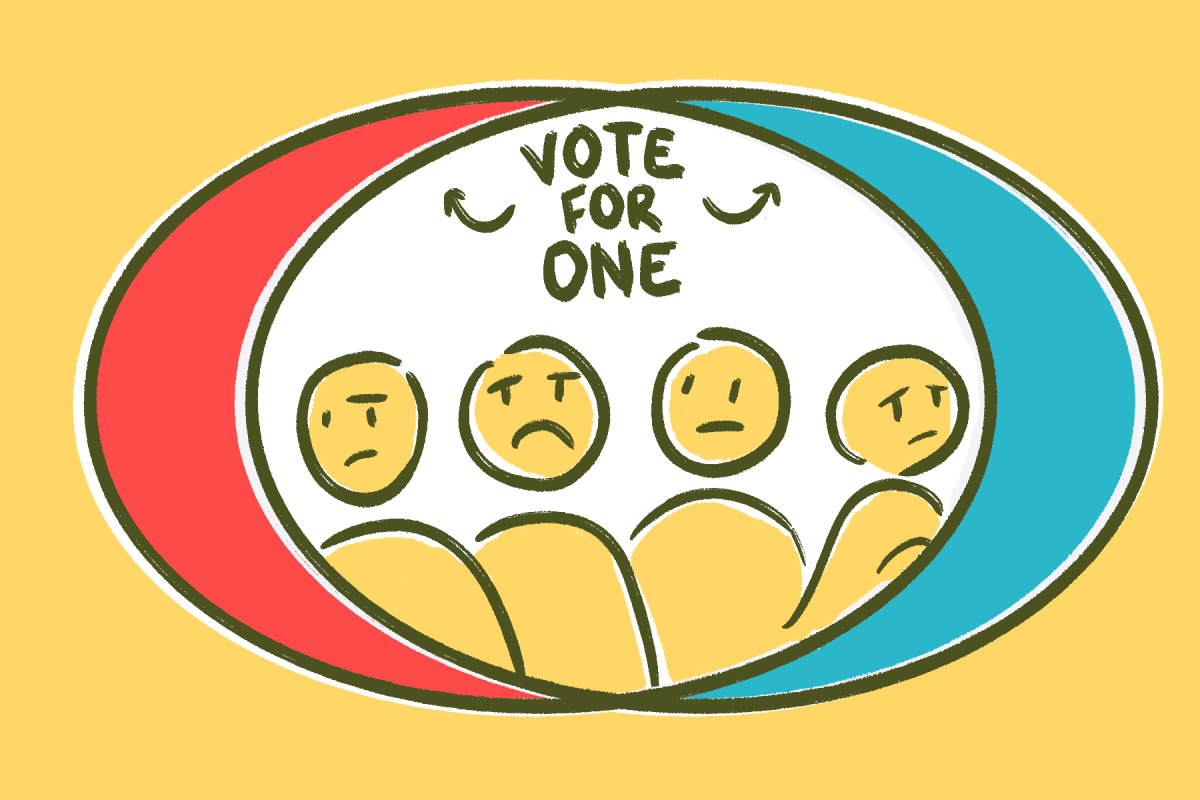Say you want to purchase a car. You will likely take time to assure that the purchase will be worthwhile by gathering information about the car and the manufacturing company: reading customer reviews, researching the company, and understanding how the car you might purchase is different from other cars on the market. Voting is not unlike purchasing a car. It is an important decision that should be made with careful consideration and diligent research.
The two-party system compels most voters to subscribe to one of two political ideologies. While third-party candidates exist, their campaigns are not exposed to nearly enough media coverage as Democratic or Republican candidates. For instance, Vermont Senator Bernie Sanders identifies as independent. However, during his presidential bid in 2016, Sanders ran as a Democrat. He justified his decision by citing reasons relating to lack of media coverage and minimal access to funding from interest groups. Thus, voters are ultimately asked to cast their ballot for either the Democratic nominee, the Republican nominee, or a third-party candidate which they have likely not heard of.
The framework of our electoral process inevitably results in a stratification of the voter base by key demographic factors. These factors can include but are not limited to: race, religious status, gender, education level, and age. To determine the extent to which these strata may be distinct from one another with regards to how they vote, a colleague and myself conducted a regression analysis. My colleague, Antoinette White, compiled a large set of data from the General Social Survey, including over 35,000 different observations. These observations were used to determine if specific variables will demonstrate a significant prediction of how an individual will cast their vote — Democrat or Republican.
Analysis of the GSS data demonstrated that four variables are quite significant in predicting how a person will vote. These are being religious, white, educated or not, and living in the East. Our findings showed that being religious will increase the probability of voting Republican by 37.24%. Being white will increase the probability of voting Republican by 52.31%. Having a higher education degree will decrease the probability of voting Republican by 15.53%. Living in the East also decreases the probability of voting Republican by 22.17%. Given that being religious and white are the two variables most significant when predicting how an individual will vote, we decided to create a new variable to see if there is any interaction between them. After rerunning regression tests, analysis showed that being both white and religious would increase the probability of an individual voting Republican by a substantial percentage of 96.72%.
It is important to note that there is a key distinction between causation and correlation among these findings. They do not imply that an individual is destined to vote one way or another simply on the basis of their religious status, ethnicity, education, and geographic location. Our findings are a recognition of statistically significant observable trends and tendencies in voter behavior.
Political socialization is a life-long process by which we discover our political identities. Our values are shaped by our experiences with our family members, teachers, and mentors. Naturally, it makes sense that we stand firmly by our political affiliations like we stand by our values and culture. However, this aspect of human behavior is part of the problem. As it relates to this piece, a study by Russell J. Dalton from the Oxford Research Encyclopedia of Politics, demonstrated that partisan individuals “tend to repeatedly support their preferred party, even when the candidates and the issues change” (Dalton, 2016).
Dalton’s conclusions paired with our findings can reveal an unsettling truth about voter behavior in our increasingly partisan nation. From a broad perspective, the voting population of the United States is stratified by demographic factors into subsects. Not only this, these strata run the risk of continuously voting for the same candidates without acknowledging ideological shifts in the party platforms. The danger of this behavior lies in the notion that a purely representative democracy requires that public opinion be represented in our state and federal institutions. Imagine that voter turnout in the United States reached 100%. Yet this milestone becomes meaningless if voters are not voting consciously. It is of the utmost importance that your vote is an educated vote. You would not purchase a car with your eyes closed simply because you know the color of the car is blue or red. I urge every voter to do their own research on all candidates regardless if their political views align with your own. Arrive at your own conclusions.
This perspective should be completely impartial with respect to partisan affiliation. Ideally, voters should approach formulating their opinions on a policy by policy basis. In making their decision on which candidate they vote for, they should consider the aggregate support of policies they have in common with the respective candidate. If voters adopt this approach, we as a nation can move closer and closer to possessing institutions that provide a mirror image of the public interest.
Kiyanoush Forough is a junior double-majoring in finance and economics at UTD.






